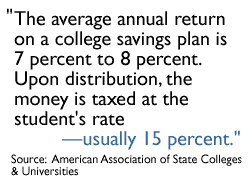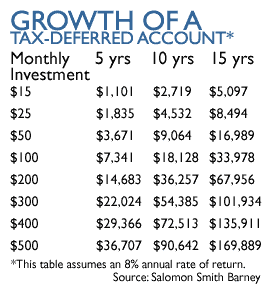|
College bills and tax breaks
|
 |
March 9, 2000: 6:31 a.m. ET
Qualified state tuition plans help ease financial pain of higher education
By Staff Writer Shelly K. Schwartz
|
NEW YORK (CNNfn) - Time was when parents struggling to save for their children's education were forced to fend for themselves.
Middle-income families, already saddled with mortgage bills and car loans, were granted little in the way of tax breaks or government assistance to help numb the pain of surging tuition fees. Most got by on a strict diet of fiscal restraint and low-income loans.
But times change.
"Things are very good for consumers right now because there are so many (financing) options," said Travis Reindl, a policy analyst with the American Association of State Colleges & Universities (AASCU).
He's referring to Qualified State Tuition Plans, a tax-advantaged savings plan created by Congress four years ago. The plans allow parents or grandparents to contribute after-tax dollars into an education account set up for their child or loved one.
 The primary advantage to these plans is that the money grows tax-deferred. When the dollars are withdrawn to pay for college, the money is taxed at the child's rate rather than the parent's -- usually 15 percent. The primary advantage to these plans is that the money grows tax-deferred. When the dollars are withdrawn to pay for college, the money is taxed at the child's rate rather than the parent's -- usually 15 percent.
You can also generally reap tax benefits on the state level. Some follow the federal guidelines, others allow contributions to be made on a pretax basis and still others allow withdrawals to be made tax-free.
"More and more people are taking advantage of these plans," said Joseph Hurley, a certified public account, author and founder of savingforcollege.com. "They seem to be growing quite rapidly in popularity, mainly because people are just now finding out about them. You still find a lot of people who just don't know much about them."
The difference between plans
Qualified State Tuition Plans come in two varieties: prepaid tuition plans and college savings plans.
They differ by state, but prepaid plans generally allow you to buy blocks of college credit hours over the course of several years -- based on today's tuition costs.
If, for example, four years of in-state college costs $15,000 today, you would sign a contract locking in that fee and establishing a multi-year payment plan. If tuition by the time your child reaches college eight years from now has climbed to $23,000, you pay nothing more.
You would, however, have to pay taxes on the $8,000 difference, or appreciation. But again, it's taxed at your child's rate, not yours.
"A prepaid tuition plan is attractive to a family that just wants to make sure they've paid for the future tuition at a public university and they don't want to worry about which direction the markets are going," Hurley said.
If you're considering signing up for a prepaid tuition plan, keep in mind that the money in your account can only be used for tuition. Room and board is usually not an allowable expense.
To qualify for the tax advantage, the money must also generally be used at an in-state school, but some plans these days allow the account holder to apply that money toward out-of-state tuitions with minimal penalties. Moreover, virtually every plan allows for a transfer of those funds to another child if the primary beneficiary decides not to attend college.
And in the worse-case scenario, if your child decides not to attend college at all, you can withdraw that money and pay only minimal penalties on the distribution along with your regular taxes.
For a quick look at what type of tax-advantaged plan is available in your state, if any, savingforcollege.com offers a special section that provides details on each program and rates them based on their performance history.
College savings plans
College savings plans are quite different. These plans are less of a savings tool and more of a market-driven investment. As a result, they bear a higher risk and reward potential.
"The individual with a college savings plan is someone who might otherwise be investing in taxable funds for their child's college education and they'd like to be able to put that money in a tax-advantaged savings account," Hurley notes.
When you open up such an account, you agree to contribute a fixed amount of money each month through regular paycheck deposits -- allowing your  money to benefit from the principals of dollar cost averaging. money to benefit from the principals of dollar cost averaging.
Based on your time horizon, the money is invested in a variety of mutual funds at the discretion of the state and investment firm handling the program. In Colorado's case, the state hired Salomon Smith Barney to oversee an account, which is invested in any number of mutual funds.
Fidelity's UNIQUE Investing Plan, for example, is a college savings plan open to all U.S. residents. It can be used at any state-accredited college or university and it provides numerous outside benefits.
In addition to the standard federal tax breaks, Fidelity's UNIQUE plan allows individuals to leave to a student beneficiary a gift of up to $50,000 in a single year, without triggering the gift tax that usually kicks in after $10,000.
To do this, you must treat the entire gift as a series of five equal and annual gifts -- $10,000 each year for five consecutive years. During that time you can not make additional gifts.
College savings plans are open to all U.S. citizens and the money in the account can be used at all state-accredited institutions. Moreover, the money is not restricted to tuition alone. In most cases, the money can be used to pay for books and room and board.
When it comes to the types of plans, keep in mind that the size of your account and the ability of your child to graduate from college debt-free, rises and falls with the success of the mutual funds in which it invests. You have no control over the investment itself, and most options only allow you to invest up to $100,000.
According to the AASCU, college savings plans generally yield returns of 7 percent to 8 percent.
Neither the prepaid tuition plans or college savings plans preclude the beneficiary from qualifying for the Hope Scholarship tax credit or Lifetime Learning credit -- the other two educational assistance programs created under the Taxpayer Relief Act of 1997.
"(Qualified State Tuition Plans) offer an unparalleled opportunity to save for a child or loved one," said Andrea Feirstein, director of college savings and affinity programs for Salomon Smith Barney, which administers Colorado's "Scholars Choice" college savings plan. "With these programs, no child should miss the opportunity to pursue his or her education dreams for financial reasons alone. It's a wonderful investment opportunity with great tax benefits."
What's the big deal?
If you're wondering how much a qualified state tuition plan can save you, the answer is it depends on the type of plan you choose and the amount you're willing to invest. Both plans can help you give your kids the gift of a college education, but it's still going to take some significant savings on your part.
Here's a rough example, based on Salomon Smith Barney's Scholars Choice data:
Family A contributes $500 a month to a taxable account earning 8 percent annual returns starting when a child is three years old. The family pays taxes on dividends and capital gain distributions annually, with a combined federal and state tax rate of 33 percent, and it also pays capital gains taxes when they redeem the investment to pay for college. By the time the child, withdraws the money at age 18, the account will have amassed $136,852.
Family B, on the other hand, contributes the same monthly amount when a child turns three to a college savings plan earning the same returns. Its earnings are not taxed, and the family does not pay state or federal taxes on dividends and capital gain distributions. When they redeem their investment to pay for their child's education, the earnings are taxes at the child's federal income tax rate of 15 percent -- yielding a grand total of $157,906.
That's a difference of $21,054.
And don't blow off the power of tax-deferred earnings. By saving just $50 a month for 10 years in an account yielding 8 percent -- a historic average --your dollars will grow to nearly $9,100. Savings of $100 per month in a similar fund for 15 years would be worth almost $34,000.
Many mutual funds over the last five to 10 years have been growing at two to three times that rate.
 The deciding factor The deciding factor
So how do you determine which plan is right for you?
"It depends on what kind of consumer you are," said Reindl of the AASCU. "First of all, it depends on your attitude toward risk. A lot of Americans are very intimidated by the notion of investing when it comes to their children's education fund. They take more of a stuff-it-under-the-mattress approach, and for those people the prepaid tuition plan provides real peace of mind."
Those willing to risk a little more for the higher return potential might feel more comfortable signing up for a college savings plan, instead.
Keep control
Part of the allure of the Qualified State Tuition Plans, experts say, is that both varieties allow the parent or grandparent to retain control over their investment.
In the past, those who wanted to pass on part of their assets to a child or loved one and reap the benefit of tax write-offs could do so only through the Gift to Minors Act, in which a custodian account was set up on behalf of the child. Trouble was, even the most well-intentioned child could view the money as a green light to spend their summer following the Grateful Dead.
"That has become a significant issue to worry about in many families, since that custodian account is owned by the child," Hurley said. "The benefit of the Qualified State Tuition Plan is that you continue to have complete control over the account as the account owner and the child won't get its hands on the money until you allow it.
Those following the industry estimate there are 38 qualified state tuition programs established to date, with more on the way.
"The market is going to catch on once people realize the value of these tax advantaged programs," Hurley predicts. 
|
|
|
|
|
 |

|

